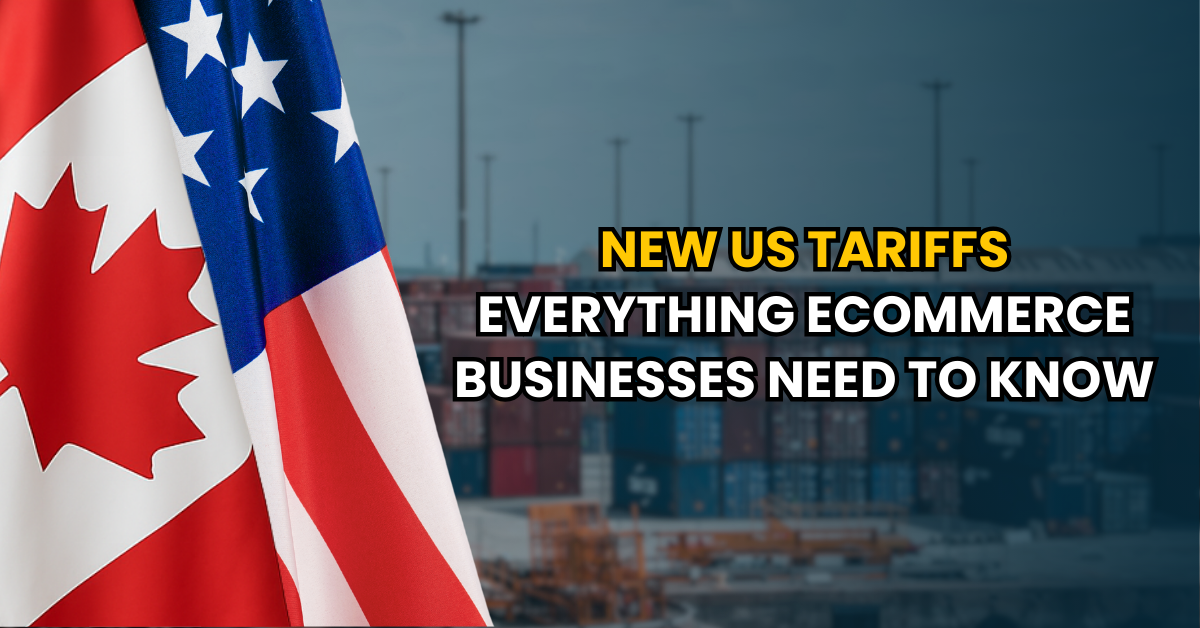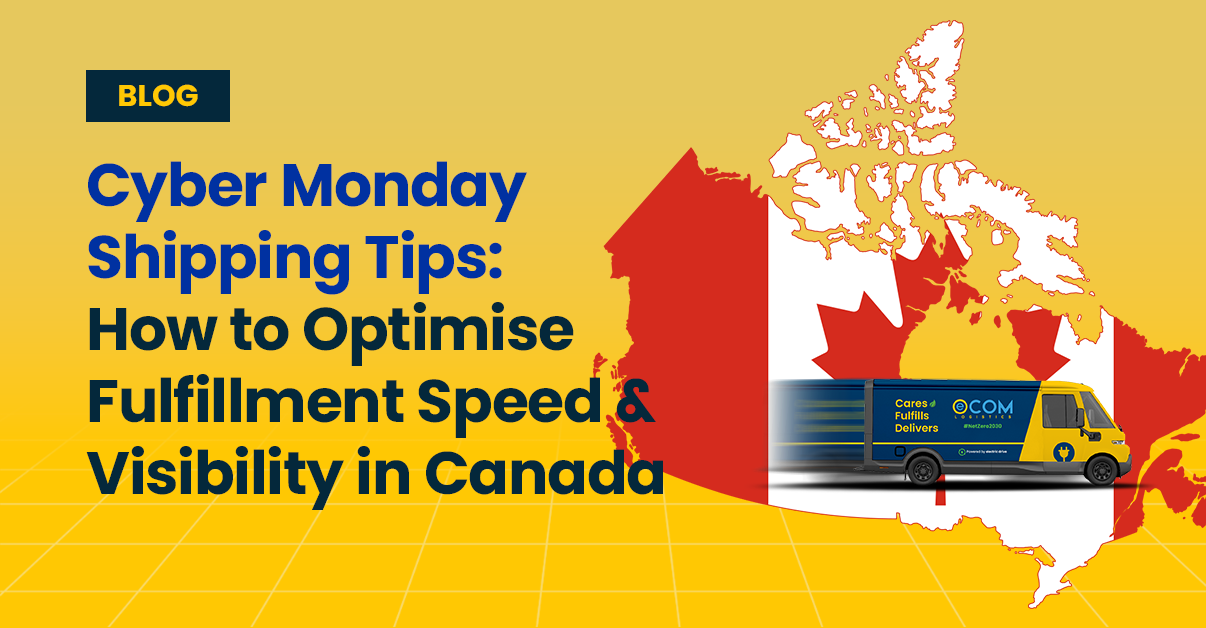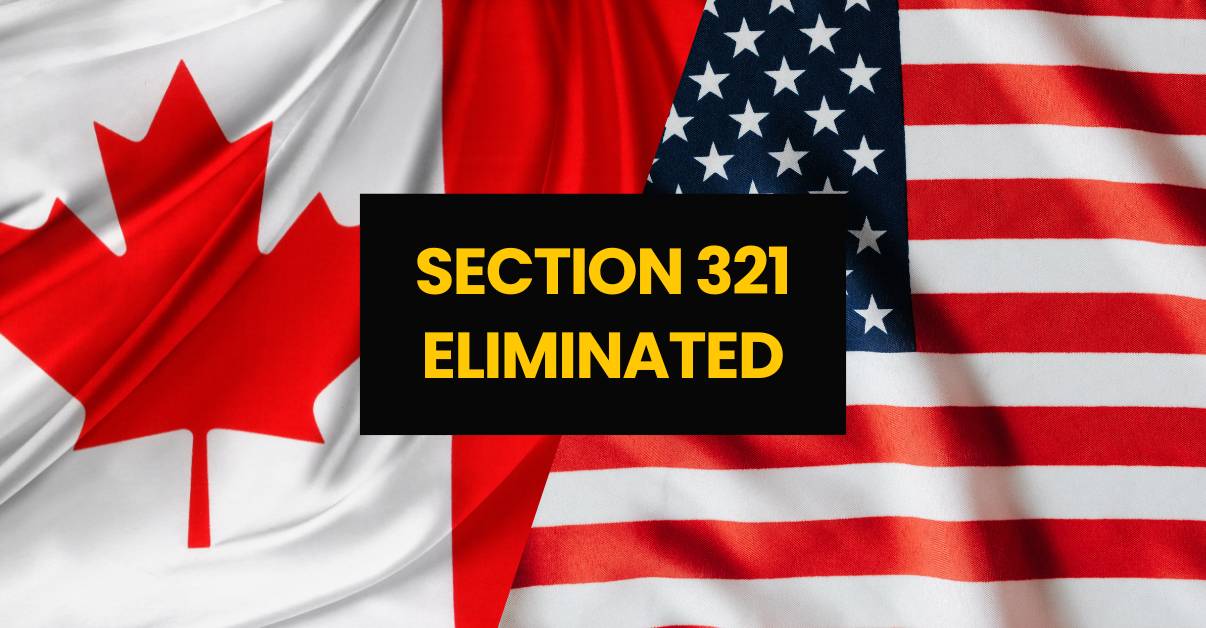(April 2025 Update)
Shipping to the U.S.? You need to read this.
On April 2, 2025, President Donald J. Trump issued a sweeping Executive Order that will reshape how goods enter the United States. At the heart of the order? A new reciprocal tariff regime aimed at rebalancing what the administration views as decades of one-sided trade relationships.
While this move is meant to protect U.S. manufacturers and reduce trade deficits, the ripple effects are immediate and real for Canadian businesses — especially those that rely on cross-border e-commerce. Whether you’re shipping skincare to Seattle, pet food to Portland, or apparel to Austin, these changes could impact your shipping costs, customer pricing, fulfillment model, and overall competitiveness.
So what does this mean for you?
We’ve compiled a comprehensive, easy-to-navigate guide answering the top questions Canadian e-commerce businesses are asking right now — from how the new tariffs work to what qualifies for exemption, how the de minimis rule is changing, and what strategies you can implement to protect your margins.
Let’s break it all down — no jargon, just the facts (and some action steps you’ll thank yourself for taking).
Quick Recap: What Happened in March 2025 Between the U.S. and Canada?
Before we jump into the latest round of tariffs from April, let’s rewind for a second. Because for Canadian businesses shipping to the U.S., March 2025 was already full of major trade changes — and they set the stage for what came next.
Here’s a quick look at what went down:
March 4, 2025: Surprise Tariffs on Canadian Goods
The U.S. kicked off the month by slapping a 25% tariff on most Canadian imports, with a slightly lower 10% tariff on energy products like oil and potash.
Why? According to the U.S. government, this was about more than trade — they tied it to issues at the northern border, citing concerns over illicit drug flow and national security.
So if you were shipping just about anything to the U.S. that didn’t qualify under USMCA, it suddenly got a lot more expensive to do business.
Source: Dentons Trade Alert
March 12, 2025: Steel & Aluminum Tariffs Return
Just over a week later, things escalated. The U.S. rolled out a 25% tariff on steel and aluminum from all countries, including Canada.
If your e-commerce business deals in products that include these materials — like home hardware, kitchen goods, or furniture parts — you probably felt this one.
It was framed as a national security issue again, focused on protecting domestic manufacturing.
Source: PwC Canada Bulletin
March 13, 2025: Canada Hits Back
Canada didn’t stay quiet. The next day, it responded with its own set of tariffs — a 25% hit on nearly $30 billion worth of U.S. goods.
That list included everything from steel and aluminum to U.S.-made cars, furniture, and household goods. The message was clear: if you raise prices on us, we’ll do the same to you.
“Canada doesn’t escalate — but we do respond.”
— Prime Minister Mark Carney
Source: Government of Canada Tariff List
What This Means for Canadian E-Commerce
If you sell physical products to U.S. customers — especially things made with metal or other industrial materials — your costs likely increased in March.
And if your products don’t qualify under USMCA? You’re likely seeing those March tariffs stack with the new April ones.
Whether you ship via Shopify, Amazon, Etsy, or your own site — these trade changes impact:
- Shipping costs
- Pricing and profit margins
- Fulfillment strategies
The March tariffs made it clear that U.S.-Canada trade was entering a new phase. And the April 2025 order took it even further.
Let’s break that down next.
What Are the New U.S. Tariffs—and When Do They Take Effect?
Following the earlier trade measures announced in March, the U.S. government has introduced a broader and more structured tariff policy. On April 2, 2025, President Donald Trump signed a new executive order establishing a reciprocal tariff system aimed at addressing persistent trade deficits and protecting domestic manufacturing.
Here’s what Canadian e-commerce businesses need to know:
April 5, 2025: 10% Tariff on All Imports (Including E-Commerce)
Starting April 5 at 12:01 a.m. ET, the U.S. is charging a 10% tariff on nearly every imported product, no matter where it’s coming from. This includes everything from consumer products and raw materials to goods sold by Canadian e-commerce brands. If you’re shipping to U.S. customers and your product doesn’t qualify for an exemption — you’re likely paying this extra 10%.
What this means for you:
If your products don’t qualify under USMCA, or aren’t listed as exempt, they’ll be taxed an additional 10% at the border when they enter the U.S. This is on top of any other duties you might already pay.
This move is part of the U.S. administration’s push to reduce a massive $1.2 trillion trade deficit and encourage more local manufacturing.
Source: Wall Street Journal
April 9, 2025: Country-Specific Tariffs (Canada = Up to 25%)
Then, on April 9, the U.S. is introducing even stricter tariffs for specific countries — and Canada is on the list.
Here’s the breakdown for Canadian businesses:
| Product Type | Tariff Rate in U.S. (Starting April 9) |
| USMCA-Qualified Goods | 0% (Still Duty-Free) |
| Non-USMCA Goods (Most Products) | 25% Tariff |
| Non-USMCA Energy & Potash Products | 10% Tariff |
- Good news: If your product qualifies under USMCA, nothing changes — you still ship tariff-free.
- However: If it doesn’t meet USMCA requirements, you could be looking at up to a 25% tariff, depending on the product. That’s a major cost increase.
The White House confirmed this in a public statement:
“USMCA-compliant goods will continue to see a 0% tariff. Non-USMCA compliant goods will see a 25% tariff, and non-USMCA compliant energy and potash will see a 10% tariff.”
— White House Statement via WSJ
What this means for you:
Double-check if your products meet USMCA rules of origin — it could be the difference between paying 0% or 25% at the border.
What About Shipments Already in Transit?
According to the executive order, shipments that were loaded onto a vessel and in transit before April 5 or April 9 will not be subject to the new tariffs, even if they arrive after those dates. This provides some relief for businesses with goods already on the way to U.S. customers.
Source: White House Executive Order (April 2, 2025)
Understanding USMCA-Qualified Goods
One of the most important ways to avoid the newly imposed U.S. tariffs is by ensuring your products qualify under the United States–Mexico–Canada Agreement (USMCA). This trade agreement— which replaced NAFTA in 2020—continues to provide duty-free access to the U.S. market for eligible goods originating in Canada, Mexico, or the United States.
But here’s the key: not all Canadian-made products automatically qualify. To benefit from USMCA exemptions, your goods must meet specific rules of origin.
What Makes a Product USMCA-Qualified?
To be considered USMCA-qualified, your product must meet two main criteria:
1. Origin of Production or Substantial Transformation
USMCA-qualified goods are products that are either:
- Fully produced in Canada, the United States, or Mexico; or
- Substantially transformed in one or more of those countries using regional materials.
2. Rules of Origin Compliance
Your product must meet minimum content requirements—meaning that a certain percentage of the materials or value must come from within North America.
For example:
- Many automotive and manufactured products must contain at least 75% North American content to qualify.
- Apparel and textiles may have stricter requirements based on fabric sourcing and assembly location.
- Electronics and packaged goods are subject to different thresholds depending on the product classification.
In short: if your supply chain includes significant inputs from outside North America, your product may not qualify.
What’s Happening with the De Minimis Threshold?
If you run an ecommerce business that ships smaller orders to the U.S., the de minimis rule has likely been working in your favour—until now.
The de minimis threshold is the minimum value under which goods can enter the U.S. without incurring duties or complex customs processing. For years, this threshold has been set at $800 USD, making it easy and cost-effective for Canadian businesses—especially direct-to-consumer (D2C) brands—to send low-value parcels to American customers.
But with the new executive order signed on April 2, 2025, the future of this rule is starting to shift.
What’s Changing?
The order confirms that, as of April 2025, duty-free de minimis treatment under 19 U.S.C. 1321(a)(2)(A)-(B) is still in place for many goods. So if you’re shipping individual consumer orders under $800 USD, the process is still relatively smooth—for now.
However, there’s a big caveat.
The order includes a provision (under 19 U.S.C. 1321(a)(2)(C)) that opens the door for ending duty-free treatment on low-value commercial imports—once the U.S. Department of Commerce confirms it has the systems in place to track, process, and collect duties on them efficiently.
In simpler terms:
The U.S. plans to eventually close this loophole for commercial shipments, and that could happen sooner than you think.
Who Will This Impact the Most?
This change could hit hard for:
- D2C brands shipping small orders to customers in the U.S.
- Subscription box businesses using third-party logistics (3PLs) to fulfill under-$800 shipments
- Canadian sellers on platforms like Etsy, Amazon, and Shopify who rely on frequent low-value cross-border deliveries
- Fulfillment services that batch and ship individual parcels from Canada to the U.S.
In many cases, these sellers have benefited from de minimis to avoid tariffs and extra documentation. If the rule changes, those benefits could disappear overnight, adding unexpected costs and delays to your fulfillment strategy.
Whether you’re shipping a single T-shirt, a skincare kit, or a holiday gift bundle, it’s time to reassess your shipping strategy before the exemption disappears.
Source: Official Executive Order – White House (April 2, 2025)
Are Any Products Exempt from the New U.S. Tariffs?
Yes — not all goods are subject to the new tariffs introduced in April 2025. If your products fall into certain categories, you may be able to avoid or reduce the tariff impact altogether. But as always, the details matter.
Here’s a breakdown of what’s currently exempt — and what you’ll need to prove it.
1. Goods That Qualify Under USMCA
If your product meets the USMCA (United States–Mexico–Canada Agreement) rules of origin, it is exempt from both the 10% general tariff and the 25% country-specific tariff.
To recap, USMCA-qualified goods must:
- Be produced or substantially transformed in Canada, the U.S., or Mexico
- Contain a required minimum percentage of North American materials or value (varies by product)
If your goods are USMCA-compliant and properly documented with a Certificate of Origin, they can continue to enter the U.S. duty-free — even under the new executive order.
2. Exemptions for Critical Goods
Certain “strategic” or “critical” goods are also excluded from the new tariffs, regardless of their country of origin. These include products considered essential for public health, infrastructure, or national security. According to the Executive Order, this list includes (but is not limited to):
- Pharmaceuticals
- Semiconductors
- Energy products
- Copper and certain critical minerals
- Medical supplies and some high-tech components
These exemptions are part of the U.S. government’s efforts to avoid disrupting supply chains for critical sectors.
3. Items Already Covered Under National Security Tariffs
Some goods were already subject to separate tariffs under national security provisions, like those imposed under Section 232 of the Trade Expansion Act. This includes:
- Steel and aluminum products (subject to 25% tariffs since 2018)
- Automotive parts from certain countries
If your products are already covered under these existing tariffs, the new reciprocal tariff regime will not apply an additional charge. In other words, they won’t be double-taxed.
4. Energy Products and Potash (Special Cases)
If you’re exporting energy-related goods or potash that don’t qualify under USMCA, they may still fall under a reduced 10% tariff, rather than the full 25% rate. This exception is meant to protect key imports that contribute to North American energy stability.
Still, you’ll need to check specific HTS codes and confirm eligibility through proper documentation.
5. What If Your Product Contains U.S. Components?
Here’s a helpful exception: if your product is made in Canada but includes U.S.-made components or materials, you may qualify for a partial exemption.
Under the new rules, only the non-U.S. portion of the product’s value is subject to the tariff, as long as:
- At least 20% of the product’s value is made up of U.S. content
- You have proof of origin and supporting documentation to verify the U.S. contribution
This is especially relevant for businesses that assemble products in Canada using U.S.-sourced parts, electronics, fabrics, or packaging.
Example:
If you sell skincare kits manufactured in Canada using containers and labels made in the U.S., and those components account for 25% of the total value, you’ll only be taxed on the 75% that isn’t U.S. origin.
6. Is There a Way to Apply for Additional Exemptions?
In some cases, businesses may be able to apply for exclusions or seek relief from tariffs through official U.S. trade channels. These processes usually require:
- A formal application
- Evidence of economic hardship or supply chain disruption
- Proof that the product isn’t available domestically in the U.S.
While this is not an immediate solution (and can take time), it’s an option worth exploring—especially for high-volume importers or businesses with niche product lines.
Tip: Consult a trade lawyer or customs broker if you think your product might qualify for a custom exemption.
Who’s In the Clear?
You’re in a good position if:
- Your product qualifies under USMCA
- You’re exporting pharmaceuticals, semiconductors, or other exempt critical goods
- Your product includes U.S.-made components (20% or more of the value)
- Your product is already covered under other national security tariffs
Even in a changing trade environment, not all hope is lost for Canadian exporters. The key is to understand your product’s classification, origin, and content, and to document everything properly.
Canada Responds with Retaliatory Tariffs
In response to the new U.S. tariffs, the Canadian government has announced targeted countermeasures aimed at key American industries. On April 3, 2025, Prime Minister Mark Carney confirmed that Canada will implement a 25% retaliatory tariff on U.S.-made vehicles that do not meet USMCA (CUSMA) requirements.
This move is part of a carefully calibrated strategy to protect Canadian interests without escalating broader trade tensions. Notably, auto parts are excluded from the tariff, allowing manufacturers and supply chains to avoid further disruption.
According to Global Affairs Canada, this measure is expected to impact approximately $8 billion CAD in U.S. vehicle imports. It follows two previous rounds of Canadian counter-tariffs introduced in March 2025, which remain in place.
Interestingly, Canada has paused a broader $125 billion counter-tariff list that was under consultation by the Department of Finance. This list included many consumer goods and retail items, so its delay is welcome news for Canadian importers and retailers who were bracing for more sweeping price increases.
“We’re standing up for Canadian workers, but doing so with precision. Our focus is on protecting our economy without fueling unnecessary inflation.”
— Prime Minister Mark Carney
Sources:
Impact on E-Commerce Supply Chains and the Broader Economy
With the new U.S. tariff measures now in place, Canadian e-commerce businesses are facing more than just higher costs—they’re looking at a potential shake-up across their entire supply chain. From tighter profit margins to customs delays, the ripple effects are real—and they’re already being felt.
Why This Matters for Canadian Online Sellers
The U.S. remains Canada’s largest trading partner, importing more than $400 billion CAD in goods annually (StatCan, 2024). For many e-commerce brands, especially those selling on platforms like Shopify, Amazon, and Etsy, the American market isn’t just important—it’s essential.
That’s why these new tariffs pose a significant challenge to everyday operations, especially for D2C brands relying on cross-border logistics.
Here’s what could change:
- Profit margins may shrink as duties add to cost of goods sold
- Delivery times could increase, especially if shipments face longer customs processing due to stricter enforcement
- Customer experience may decline if buyers are hit with unexpected import fees or longer wait times
- Return processes may become more expensive or complicated, particularly for small businesses managing fulfillment in-house
What This Means for Cross-Border Logistics
Beyond the direct costs, these new tariffs are likely to result in:
- Stricter documentation requirements
- Longer border clearance times
- More frequent inspections or tariff audits
That means businesses need to start working closely with their fulfillment partners, 3PL providers, and customs brokers to anticipate delays and prevent disruptions. Proactive communication and supply chain visibility are more important than ever.
If you’re using a Canadian fulfillment centre to ship into the U.S., now is a good time to assess whether this model remains sustainable—or if it’s time to explore U.S.-based warehousing options to maintain a frictionless experience for your American customers.
Economic Concerns and Uncertainty
These tariffs aren’t happening in a vacuum. The broader global reaction has been swift—and uneasy.
Since the announcement of the executive order, global stock markets have seen declines, and multiple countries have signalled their intent to impose retaliatory tariffs. According to AP News, economists are warning of rising inflationary pressure, supply chain volatility, and a slowdown in economic growth—both in the U.S. and Canada.
For Canadian e-commerce brands, this means:
- More price sensitivity from U.S. consumers
- A possible decline in cross-border sales volume
- Rising input costs, particularly for products sourced from Asia or Europe that are routed through the U.S.
With Asian nations being disproportionately affected by U.S. tariff policies, American retailers and marketplaces that source from those regions may see cost hikes—potentially leading to price increases across multiple product categories. That pressure could spill over into Canada, creating new pricing challenges for Canadian brands selling to both U.S. and domestic customers.
What You Can Do Now
While the situation is still developing, here are some proactive steps you can take:
- Review your U.S. shipment volumes and fulfillment strategy
- Update your product pricing to reflect new duty scenarios
- Communicate clearly with U.S. customers about potential delays or added fees
- Explore supply chain diversification, including alternate markets or domestic fulfillment options
- Work with trade compliance advisors to ensure documentation is accurate and exemptions are maximized
Final Thought
This is a pivotal moment for cross-border commerce. While the U.S. tariffs are designed to address long-term trade imbalances, the short-term impact for Canadian e-commerce brands is real—and demands action.
The more prepared your business is to adapt—through smarter logistics, pricing strategy, and compliance—the better positioned you’ll be to navigate what could be a turbulent few months ahead.
About Ecom Logistics
Ecom Logistics helps e-commerce businesses in Canada to move smarter, faster, and more confidently—especially when it comes to cross-border trade. From customs clearance to last-mile delivery, our end-to-end logistics solutions are built to simplify operations and keep your business fully compliant in a changing regulatory landscape.
Here’s how we support your success:
- Customs Clearance: We take the complexity out of customs by managing the entire process—so your shipments cross borders without delays.
- Documentation Management: Say goodbye to paperwork headaches. We handle the required shipping and trade documentation to keep your operations efficient and audit-ready.
- Regulatory Compliance: With global trade rules evolving rapidly, we stay on top of every update—ensuring your shipments remain compliant with U.S., Canadian, and international requirements.
- Shipping Optimization: From courier selection to route planning, we help you find the fastest and most cost-effective way to deliver.
- Warehousing & Fulfillment: Our tech-enabled fulfillment centres offer flexible, scalable storage and shipping solutions tailored to your business model.
Whether you’re dealing with the changes or preparing to scale your business, Ecom Logistics is your trusted 3PL partner.
Let’s future-proof your logistics—contact us today.
Frequently asked questions
1. How can I determine if my products qualify for USMCA exemptions to avoid the new tariffs?
To qualify for USMCA exemptions, your products must meet specific rules of origin, meaning they should be produced or substantially transformed in the U.S., Canada, or Mexico, with a certain percentage of materials sourced from within these countries. It’s essential to conduct a thorough analysis of your supply chain and maintain proper documentation to certify eligibility. Consulting the U.S. Customs and Border Protection’s USMCA FAQs can provide further guidance.
2. With the de minimis threshold potentially changing, how should I adjust my shipping strategy for low-value orders?
The de minimis threshold currently allows shipments under $800 USD to enter the U.S. duty-free. However, recent executive orders suggest this exemption may soon be revoked, particularly for imports from countries like China. To adapt, consider consolidating shipments to reduce the number of low-value parcels or exploring fulfillment centers within the U.S. to minimize cross-border complexities.
3. What steps can I take to mitigate the impact of increased tariffs on my e-commerce business?
To lessen the effect of tariffs, explore diversifying your supplier base to include countries not subject to high tariffs, reassess your pricing strategy to account for increased costs, and investigate the possibility of shifting parts of your supply chain or fulfillment operations to the U.S. to reduce exposure to cross-border tariffs. Staying informed about trade policy changes and seeking advice from trade compliance experts can also be beneficial.
4. Are there any specific documentation requirements to claim tariff exemptions under USMCA?
Yes, to claim preferential tariff treatment under USMCA, a certification of origin is required. Unlike the previous NAFTA agreement, USMCA does not mandate a specific certificate of origin form. Instead, it requires a set of minimum data elements that can be included on an invoice or any other document. Ensuring accurate and complete documentation is crucial for compliance and to benefit from tariff exemptions.




